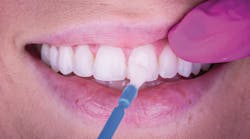Fluoride varnishes: What's the difference, and which one is best?
Editor's note: Originally posted in 2020 and updated regularly
Fluoride’s effectiveness in preventing tooth decay and dentinal hypersensitivity is well known. Fluoride treatments are supported by the World Health Organization, the Centers for Disease Control and Prevention (CDC), as well as many other agencies. Fluoridation of public water is considered to be one of the most successful public health acts in the fight against dental decay, according to the CDC.1 There are numerous types of professional fluoride applications that can be provided in the dental office as treatment for adults and children. The American Dental Association recognizes 5% sodium fluoride (NaF) or 2.26% fluoride content varnish treatment for the benefit of caries prevention when given at least twice per year to children up to age 18.2 Sodium fluoride varnishes are also recommended for prevention of root caries in adults when administered at least twice a year at patients’ prophylaxis appointments. It is easily interpreted that fluoride varnishes are beneficial to all age groups, especially children and individuals with high caries risk.3 So, what is the best type of varnish, and what are the differences between the various topical fluoride treatments?
Currently, we have no studies to support the clinical benefits of one type of professional fluoride treatment over another. It has been shown that the frequency and duration of tooth-to-fluoride contact are the greatest contributors to the success of a treatment modality. When comparing fluoride carriers such as varnish to toothpaste and rinse, there are no proven benefits of a specific delivery system.4 So, why a varnish, and what should we look for in one?5
Why varnishes?
As a delivery system, varnish is preferred for its ease of use, prolonged fluoride exposure time, and relative safety. A concern with other carrier modalities is that there is an increased risk of ingestion, as well as decreased contact time with the teeth. Most varnishes on the market contain 5% NaF with an alcohol- and resin-based solution. The evaporation of the alcohol makes the system fast drying, and the resin functions to allow the fluoride to adhere to the teeth. The most common resin additive is colophony, a rosin derived from pine tree sap. The carrier is the cause of the main complaint about varnish, in that it is “sticky” and leaves a noticeable film on the teeth.2
You might also be interested in: 3 ways hygienists can boost acceptance of fluoride varnish
A comparison of products
Not all products are created equal, as science has developed different additives to place in varnishes in an attempt to increase their effectiveness. Following is a comparison of some of the most common varnishes on the market.
Duraphat (Colgate) was the first varnish on the market in 1964. This varnish contains 5% NaF suspended in an alcohol-based solution of natural resins. Duraphat varnish is tinted; this is reported to be for easy visualization. The product has a high viscosity.
MI Varnish (GC America) is unlike any other varnish. It contains 5% NaF + Recaldent (CPP-ACP). Recaldent is a novel combination of casein phosphopeptide (CPP) and amorphous calcium phosphate (ACP). The casein peptide naturally occurs in milk and binds to teeth in the oral cavity, mucosa, and even biofilm, which allows the ACP to be stabilized until it reaches the teeth to recalcify tooth structures.7 MI paste and Recaldent have been greatly studied and proven to be an effective way to remineralize teeth.
Fluor Protector S (Ivoclar Vivadent) is different in that it contains 1.5% ammonium fluoride (NH4F). This varnish uses ethanol and water as solvents to allow for a decreased viscosity and increased wetting and flowability. After the solvent evaporates, the fluoride concentration is up to four times higher on the tooth surface, providing 3% fluoride content locally. To increase efficacy, a polymer additive helps the varnish to adhere to the teeth. Its transparency, homogeneity, and thin viscosity provide a high level of patient acceptance and satisfaction.8
Kolorz ClearShield (DMG America) contains 5% NaF. This varnish, as named, goes on completely clear for an esthetic appearance. This product works to improve the varnish experience with its many different flavor choices, such as watermelon, bubblegum, mint, cookie dough, and caramel, making each varnish treatment more enjoyable.
Vanish Varnish (3M) is a unique product in that it is proven to release fluoride over the course of 24 hours. As we have read, one of the greatest indicators of a fluoride treatment’s effectiveness is its duration. The longer the duration of contact with the fluoride, the greater effect it can have on teeth. Another unique component of this product is that it has tricalcium phosphate, in addition to the NaF, to help with the remineralization of teeth. This varnish is an alcohol-based suspension of modified rosin. The product reports an increased flowability and a decreased film thickness.9 Another major advantage of this varnish is its effectiveness on polished and unpolished teeth, as well as in wet or dry environments. The product’s extended release is a great advantage too.
References
1. Water fluoridation basics. Division of Oral Health. National Center for Chronic Disease Prevention and Health Promotion. Centers for Disease Control and Prevention website. https://www.cdc.gov/fluoridation/basics/index.htm. Updated January 24, 2020. Accessed February 17, 2020.
2. Professionally applied topical fluoride: Evidence-based clinical recommendations. J Am Dent Assoc. 2006;137(8):1151-1159. doi:10.14219/jada.archive.2006.0356
3. Weyant RJ, Tracy SL, Anselmo TT, et al. Topical fluoride for caries prevention: Executive summary of the updated clinical recommendations and supporting systematic review. J Am Dent Assoc. 2013;144(11):1279-1291. doi:10.14219/jada.archive.2013.0057
4. Marinho VCC, Higgins JPT, Sheiham A, Logan S. One topical fluoride (toothpastes, or mouthrinses, or gels, or varnishes) versus another for preventing dental caries in children and adolescents. Cochrane Database Syst Rev. 2004(1):CD002780. doi:10.1002/14651858.CD002780.pub2
5. Karlinsey KL. Fluoride varnishes: Why they work & what to look for. EC Dent Sci. 2016;5(6):1220-1223.
6. Martel S. A new generation of fluoride varnish is coming to you. Oral Health Group website. https://www.oralhealthgroup.com/features/new-generation-fluoride-varnish-coming/. Published September 14, 2017.
7. GC America proudly introduces MI Paste & MI Paste Plus. Frequently asked questions. GC America MI Paste Family website. http://www.mi-paste.com/FAQ_MIP.php.
8. Fluor Protector S. Ivoclar Vivadent website. https://www.ivoclarvivadent.com/en/p/all/fluor-protector-s.
9. 3M Vanish 5% sodium fluoride white varnish with tricalcium phosphate. 3M website. https://www.3m.com/3M/en_US/company-us/all-3m-products/~/3M-Vanish-5-Sodium-Fluoride-White-Varnish-with-Tri-Calcium-Phosphate/?N=5002385+8710872+8713393+3290273727&preselect=8747108&rt=rud.







